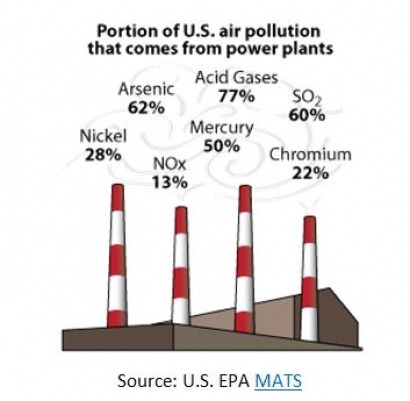
It is no surprise that several family members developed cancer. According to the American Cancer Society’s Cancer Facts and Figures 2014, “In the US, men have slightly less than a 1 in 2 lifetime risk of developing cancer; for women, the risk is a little more than 1 in 3.” If we do not develop cancer ourselves, almost certainly someone close to us will.
The causes of cancer are complex—lifestyle, diet, genetics, and environmental contaminants are all believed to contribute. We will never know which factors, or combination of factors, contributed to my family’s cancer cases, although we can speculate that environmental pollution might have played a role given that all three relatives live in heavily polluted urban areas.
Regarding environmental pollution, there is strong evidence that some cancers may be caused by exposure toxic air contaminants that emanate from combustion processes, including fossil fuel-burning electric power plants. These power plants also emit air pollutants associated with various non-cancer health effects and climate change. Where renewable energy sources replace fossil fuel plant capacity, harmful air pollution is reduced.
The World Health Organization (WHO) reports that outdoor air pollution exposure from all sources resulted in about 3.7 million premature deaths in 2012, the most recent year for which data are available. Small particles of 10 microns or less in diameter, which can cause cardiovascular and respiratory disease and cancer, were largely to blame. The majority of deaths resulted from ischemic heart disease and stroke, with a smaller number attributed to COPD, lung cancer, and acute lower respiratory infections in children.
| Causes of Death From Outdoor Air Pollution | |
| Ischemic heart disease | 40% |
| Stroke | 40% |
| Chronic obstructive pulmonary disease (COPD) | 11% |
| Lung cancer | 6% |
| Acute lower respiratory infections in children
| 3% |
WHO cites several successful policies for reducing outdoor air pollution from power generation, including these renewable energy options:
Increased use of low-emission fuels and renewable combustion-free power sources, such as solar, wind, and hydropower.
Distributed energy generation, for example, mini-grids and rooftop solar power generation.
In the U.S., the Environmental Protection Agency (EPA) is developing rules under its Clean Power Plan that would reduce carbon emissions from the power sector by about 30 percent by 2030, compared with baseline 2005 levels. These rules would also reduce by over 25 percent the pollutants that contribute to soot and smog. The EPA reports that:
These reductions will lead to climate and health benefits worth an estimated $55 billion to $93 billion per year in 2030. This includes avoiding 2,700 to 6,600 premature deaths and 140,000 to 150,000 asthma attacks in children.
Arguments against pollution controls often center on costs. However, the climate and health benefits of the Clean Power Plant rules are expected to far outweigh the costs of implementing the plan. When considering the soot and smog reductions alone, the EPA estimates that American families will see up to $7 in health benefits for every dollar invested in pollution control.
Why renewable energy is important: By replacing dirty fossil fuel-burning power plants with clean solar, wind, hydro, geothermal, and other renewable energy sources, unhealthy air pollution is reduced or eliminated. This is especially important for low income and minority populations living near power plants and industrialized areas, where exposure can be greatest.
What we can do: When writing or speaking about the advantages of renewable energy, don't forget to stress the health benefits from replacing fossil fuel-burning plants with less polluting renewables. And insist that the externalities of power production always be considered when weighing fossil fuels versus renewable sources of energy. Having clean air to breathe is a basic human right, so let’s fight for it by promoting renewable energy whenever and wherever we can!
Richard Crume works as an environmental engineer and teaches a university class on air pollution, climate change, and renewable energy. He lives in Chapel Hill, North Carolina U.S.A.

